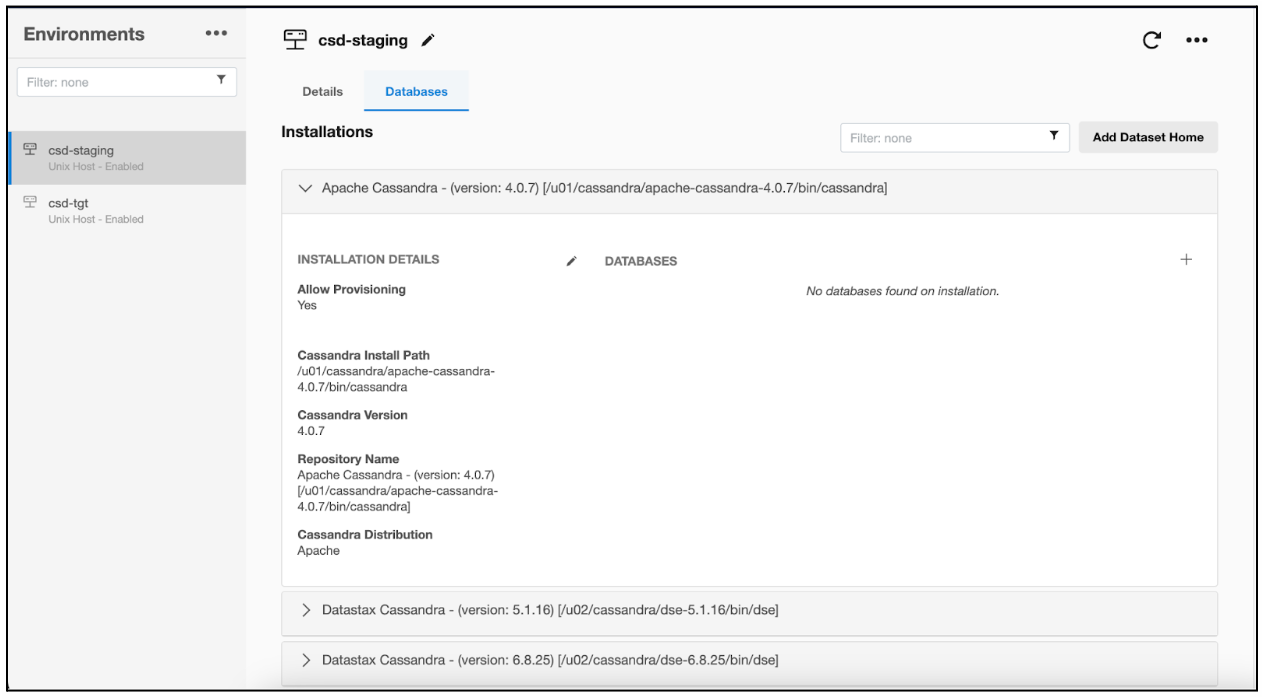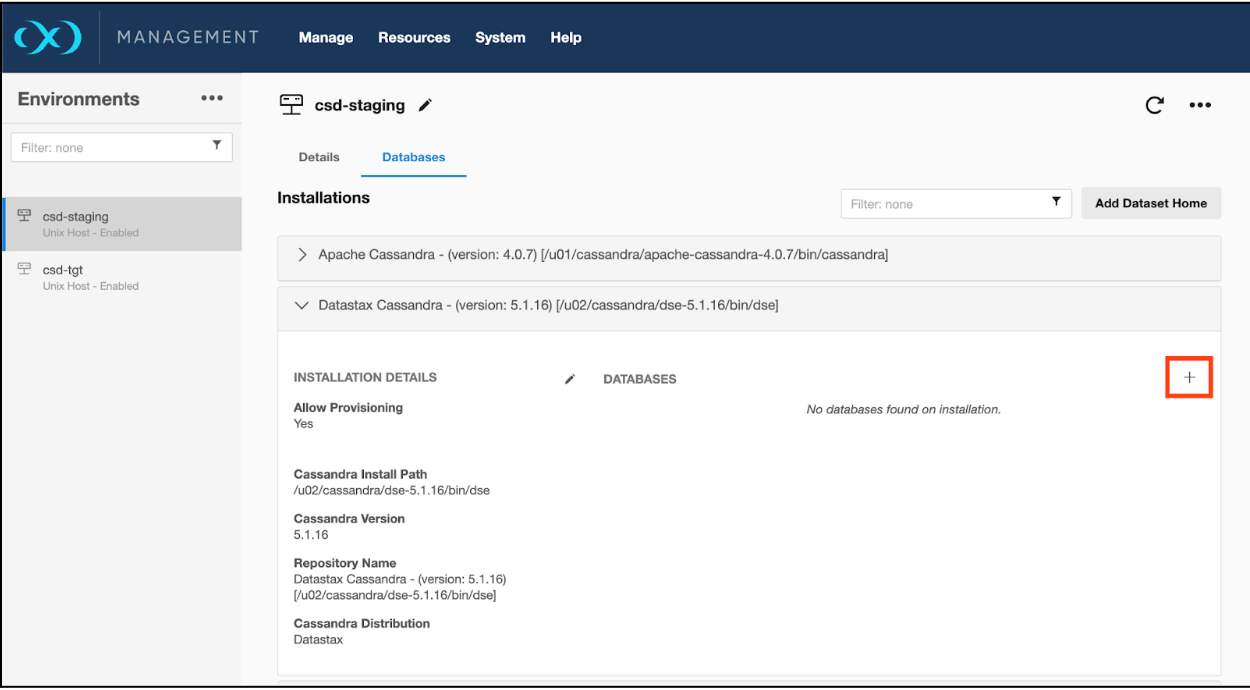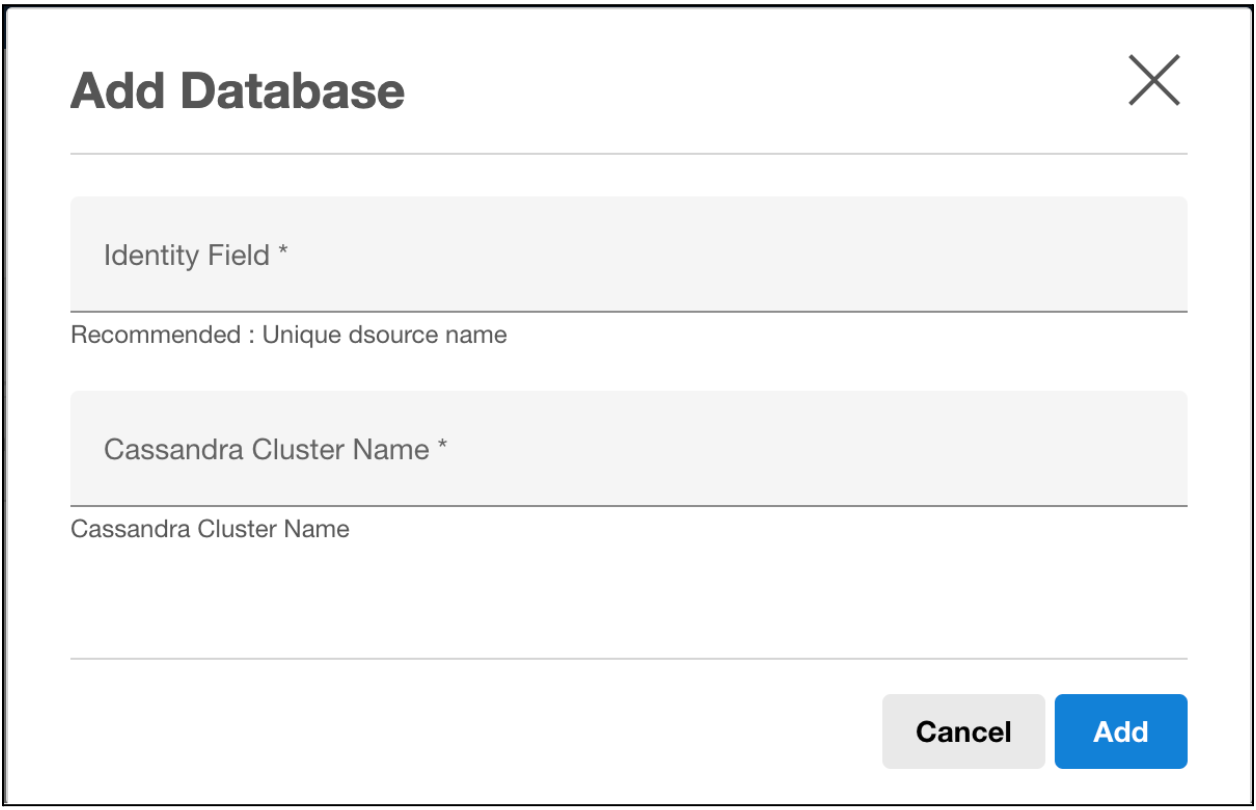Discovering Cassandra installations
Environment discovery is a process that enables the Cassandra Plugin to determine Cassandra installation details on a host. Whenever there are any changes (installing a new binary home) to an already set-up environment in the Delphix application, an environment refresh needs to be performed.
Prerequisites
Cassandra can be installed in different ways and so the installation path can vary in different environments. To discover correct software binaries information, we have the following options:
Identify the Cassandra repository through the environment variable defined by the user on the staging or target host.
Create a file name (if not present) .bash_profile or .bashrc in the home directory of the delphix OS user.
CODE>touch $HOME/.bash_profile $HOME/.bashrcDefine environment variable (CASSANDRA_REPO) pointing to Cassandra binaries installed on the host for manual discovery. Example as below:
CODE>echo "CASSANDRA_REPO=/u02/cassandra/node1/bin/dse:/u01/cassandra/apache-cassandra-4.0.7/bin/cassandra" > $HOME/.bash_profileIn case of multiple Cassandra versions installed on the same host, provide all installation paths separated with colon
(:)to the environment variable defined in .bash_profile. Example as below:CODEecho "CASSANDRA_REPO=/u02/cassandra/node1/bin/dse:/u02/cassandra/node2/bin/dse:/u02/cassandra/node3/bin/dse" > $HOME/.bash_profile
Procedure
Perform the following steps to add an environment(staging/target) to the Delphix Continuous Data Engine:
Login to the Delphix Management application.
Navigate to the Manage > Environments page.
Click the Actions ... menu and select Add Environment.
From the Add Environment dialog window, select Unix/Linux.
Select Standalone Host.
Click Next.
Provide the name of the environment.
Provide the Host IP address or host FQDN.
Provide the SSH port. The default value is 22.
Provide an Environment Username for the environment.
Choose the Login Type that fits your setup.
Username and Password – provide the environment username and password
Username and Public Key – provide the environment username
Password Vault – select from an existing Enterprise Password Vault
Note: Using Public Key Authentication
If you want to use public-key authentication for logging into your Unix-based environment, you have two options:
Use the Delphix Continuous Data Engine's key pair. For more information on how to use the Delphix Continuous Data Engine's key pair, refer to the How to use the Continuous Data Engine’s key-pair section.
Provide a key pair for this environment. As an alternative, a key pair specific for this environment can be provided via the API or CLI. For instructions, refer to CLI Cookbook: Setting up SSH key authentication for UNIX environment users.
For Password, enter the password associated with the user in step 11.
If you want to use Public Key Encryption for logging into your environment:
Select Public Key for the Login Type
Click View Public Key
Copy the public key that is displayed, and append it to the end of your ~/.ssh/authorized_keys file. If this file does not exist, it must be created.
Note: The addition of the public key is a one-time requirement per user and per environment. Additionally, you have the option to add public key authentication to an environment user's profile via CLI (for details, refer to the CLI Cookbook: Setting up SSH key authentication for UNIX environment users topic).
For Password Login, click Verify Credentials to test the username and password.
Enter Toolkit Path (ensure that the toolkit path does not have any spaces).
To provide your own Oracle Java Development Kit, select the Provide my own JDK checkbox and click Next.
On the Java Development Kit page, provide an absolute path to your Oracle JDK and click Next.
Click Submit.
After successfully adding and discovering the environment, you should be able to view the newly added environment listed under the Environments tab. In case it does not appear, click the refresh icon in your browser.
After the environment has been successfully discovered if you wish to establish further links, add a source configuration to the previously discovered installation.

Perform the following steps to access the information about any environment you have created:
Navigate to Manage > Environments.
Select the environment name.
Adding an installation to a Cassandra environment
If a new Cassandra Installation is added to the environment, then in order to reflect it into the Continuous Data UI, it is required to refresh the environment. Please refer to the "Environment Refresh" and “prerequisites” section in Managing environments and hosts for more details.
Add source config
Every environment contains repositories and each environment may have any number of repositories associated with it. TheRepository represents the binaries for Cassandra Instance. Each repository can have many SourceConfig which represent Cassandra instances.
There is no sourceconfig generated automatically in the Cassandra plugin. We need to configure SourceConfig objects through which we can create a dSource.
Procedure
Source Config is created on the Staging Environment
Login to the Delphix Management application.
Click Manage.
Select Environments.
Select the repository.
Click on plus( + )icon.

Enter a unique name for the staging database in the identify field section.
Enter a cluster name for the database in the Cassandra Cluster Name section.
Click Add button.

